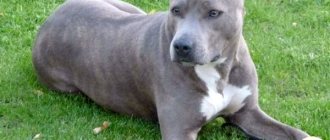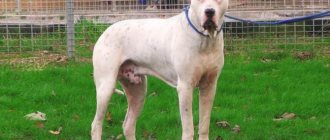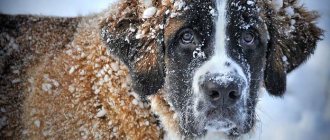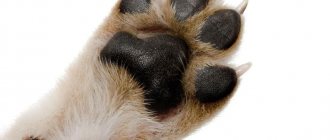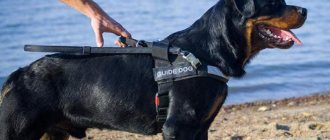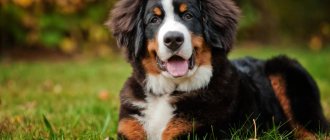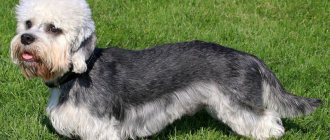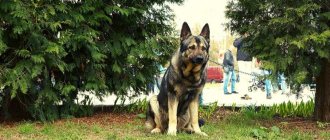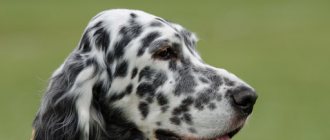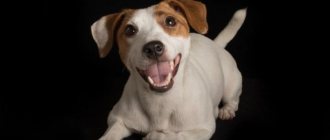Origin story and what it looks like in the photo
The history of the origin of mastiffs is quite ambiguous; it takes roots several centuries BC . The most common version says that the ancestors of the representatives of the majestic breed are Molossian Great Danes from Central Asia.
Dogs were widespread in Europe and Asia and were used as fighting dogs for baiting large wild animals (lions, tigers, bears).
Roman legionnaires used them as living weapons during hostilities, while one dog could cope with two or three armed soldiers.
At the same time, the ancestors of mastiffs were considered excellent guard dogs that protected livestock from attacks by wild animals.
These dogs came to Britain thanks to the Celtic tribes who came from Asia Minor in the 4th-3rd century BC.
It is also noteworthy that the name of the breed comes from the Latin word meaning “dog-horse”, which emphasizes the large size of the dog and its powerful physique..
How to choose a puppy
If you are planning to purchase a mastiff, carefully study the breed standard. The puppy should have straight, wide-set limbs, thick paws, soft, high-set ears, and a large square head. Fluffy fur indicates that an adult dog will have a wavy coat, which is not allowed by the breed standard.
Focus not on the biggest, but on the most active and friendly baby in the litter.
The Mastiff is a fairly rare breed, so their prices are quite high. The cost depends on the exterior class. If a pet class puppy can be bought for 20,000-40,000 rubles, then for a show class representative you will have to pay from 60,000 to 80,000 thousand rubles.
It is better to purchase a purebred puppy from a kennel with a good reputation. The organization will draw up a purchase and sale agreement with you and will issue you with a puppy certificate, which will later be replaced with a pedigree. A puppy from a kennel must have a brand. The breeder will provide you with information about the parents, vaccinations, and tell you about the feeding habits. You should not buy a dog based on an advertisement on the Internet or in the market. You risk getting a dog with a whole bunch of genetic diseases.
Description of the breed
Nowadays, when we say "mastiff", we mean the English mastiff with its characteristic features . However, the family includes several more independent species that have a common origin.
All mastiffs are united by their impressive size (some individuals reach a weight of up to 160 kg), strong muscular build, wide mouth and skin dewlap on the neck and abdomen.
There are several more common external characteristics of the mastiff family::
- the average height in the group is from 60 cm, and weight is from 50 kg;
- proportionally built body;
- strong wide body;
- muscular neck of medium length;
- wide head, flat forehead mostly with wrinkles;
- the tail is of medium length, rather thick, lowered when calm.
Among mastiffs there are short-haired representatives with short, close-fitting hair and long-haired ones.
The following species of the family are short-haired::
- English;
- Brazilian;
- bullmastiff;
- Neapolitan;
- French;
- Japanese.
The Tibetan Mastiff has long, thick hair; the Spanish and Pyrenean species have medium-length hair..
Appearance of the Spanish Mastiff
"Spaniards" are Molossian breeds. Majestic and powerful animals retain their self-esteem in any situation. Spanish Mastiffs rightfully deserve the title of Hercules in the dog world!
The breed standard determines the height of animals: for males - from 77 cm, for females - from 72 cm. Sexual dimorphism can be traced: males look stronger and stronger than females. In addition, they are characterized by greater attentiveness and observation. Body weight varies between 70-120 kg.
Head and skull
The mastiff's head is strong and large, but in comparison with the body its size is harmonious. It has the shape of a truncated pyramid with a wide base, and looks square when viewed from above. The skull is strong and proportional, with a convex profile. Its length corresponds to the width or slightly exceeds it. A bump is clearly visible on the back of the head.
Muzzle
The Spanish Mastiff's muzzle is moderately wide. Its length is in a ratio of 2:3 to the length of the skull. It has a square shape, gradually tapering from the base to the tip. The forehead is flat; the stop is slightly inclined, but poorly expressed. The straight back of the nose is lowered and goes to the lobe with wide open nostrils. The upper lip hangs over the lower lip, forming jowls. Small “pockets” are visible in the corners of the mouth. The mucosa is exposed, pigmented black.
Ears
The dog's ears are medium-sized and flattened. They have the shape of a triangle with a rounded top. Placed above the line of the outer corners of the eyes. Hanging, close to the cheeks. When the dog is alert, the tips of the ears rise slightly and bend forward.
Eyes
The mastiff's eyes appear small compared to the size of the head. They are almond-shaped and slanted. Color – brown or nut; the darker the better. The fleshy eyelids have a black edging. The lower eyelid droops, slightly exposing the conjunctiva. Although the look seems melancholic and calm, upon closer contact with the dog, firmness and severity are noticeable.
Jaws and teeth
Strong and wide jaws form a scissor bite. A complete dental formula is required: medium-sized incisors, sharp canines, premolars and powerful molars. This arrangement of teeth provides a strong grip and retention of prey. The ancestors of mastiffs used this to protect the herd from predators.
Neck
Powerful and strong, although rather short. Set high and obliquely, the muscles are well developed. Elastic leather forms a double suspension at the bottom.
Frame
The Spanish Mastiff has a rectangular and strong body. The withers are well defined. The back is long and muscular, maintaining a horizontal position even in movement. It passes into a wide and slightly convex loin, and that into a croup sloping at an angle of 45°. The height of the mastiff in this part of the body corresponds to its height at the withers. The abdomen and groin line are moderately tucked.
Tail
The tail is medium set, tapering from a wide base to the tip. At rest, it hangs down to the hocks; when moving, it is raised in the manner of a saber, but is not thrown over the back or croup.
Forelegs
Placed straight and parallel to each other. Strong bones and developed muscles are noticeable. The long arms are set at an angle of 100° to the ground. The elbows, tightly pressed to the sides of the “Spaniard,” are directed back. The forearms are vertical, forming an angle of 125° with the elbows. Their length should be three times the length of the pasterns. Massive wrist joints flow into slightly sloping and strong pasterns. The arched paws are gathered into a ball and have elastic and hard pads. The fingers end in short claws.
Hind limbs
Straight, distinguished by parallel posture. The powerful skeleton is emphasized by muscles, the angles of the joints are clearly pronounced. Wide hips extend from the croup at an angle of 100°. The lower legs are dry and long, the muscles are better developed only in the upper third. The Achilles tendon is strong. The hock joints are parallel to each other and angled back. The tarsus and metatarsus are massive, extending into arched paws. Dewclaws are acceptable regardless of their type.
Movement style
Spanish Mastiffs are characterized by a heavy trot without swaying to the sides. The higher the speed, the more the dog’s limbs are brought under the body, closer to the center of gravity. The movements are elegant, with pronounced strength.
Coat
The animals have very thick, medium-length fur that fits tightly to the body. The shoulders, chest and tail are decorated with longer hair. The shortest hair covers the spaces between the toes.
Color
The color of the Spanish Mastiff is not strictly regulated. Solid colors of sable, wolf, black, red, yellow and fawn are preferred. All possible combinations of them are acceptable, as well as markings in the form of spots or a white “collar”.
Possible defects
Among the main defects of the breed are:
- minor deviations from the sexual type;
- absence of canines, premolars or molars;
- excessive ectropy or entropy;
- “wagging” of the hind limbs;
- wavy or long hair;
- unbalanced temperament;
- straight or tucked belly;
- weak lines of the back and lower back;
- cropped ears or tail;
- tail thrown over the back;
- pointed muzzle;
- weak limbs;
- "Roman nose;
- straight bite.
Disqualifying defects include:
- undescended testicles (on one or both sides);
- excessively low or high tail set;
- depigmentation of the nose and mucous membranes;
- excessive timidity or aggressiveness;
- stockiness or long legs;
- sharp transition from forehead to muzzle;
- bifurcated nose;
- underdeveloped body;
- snack or undershot;
- loose muscles;
- humpbacked lower back;
- cow tread;
- light eyes;
- fox face;
- hare's feet;
- amble.
Character traits
Despite its fighting past, the breed is devoid of aggression and anger. Mastiffs are distinguished by their balanced and calm character. Possessing a fearless and formidable appearance, representatives of the family need constant love and care.
Mastiffs get along well with children and other animals, however, most often they are devoted to one owner, so it is not recommended to pass them from hand to hand.
Dogs of this breed are not particularly playful; their character is more like homebodies. At the same time, some individuals can be quite energetic and need constant training and jogging.
Representatives of the breed are intelligent and easy to train.
A big plus is the mastiff's guarding abilities . They treat strangers without aggression, but with caution. If someone tries to harm the owner or his family, the pet is able to prevent this.
Mastiffs are clean dogs, they are not prone to running away from home and will never wander..
Expert opinion
Kozhevin Semyon Kirillovich
Expert dog handler.
“Mastiffs are large, strong and confident dogs, they are independent and unobtrusive. These dogs are excellent guards and will do everything to please their owner. For all its majesty, the mastiff, like a child, needs communication with its owner. Proper socialization and upbringing of a pet from an early age is very important, then it will be careful with children and family friends. Be prepared for the dog to need a lot of space; it is best to have your own area. Equally important in keeping a mastiff is quality care and proper feeding.”
Character
Many dog owners have children in their families. Therefore, before adopting an animal, people study the nature of the breed and decide whether the pet can get along with small children. The characteristics of the breed describe that mastiffs are devoted to all members of their family until the end of their days. The same applies to animals that live together with a Neapolitan from the moment he appears in the house - the dog will find a common language with everyone. However, if you get another dog when the mastiff has already settled into the family, he may perceive such actions by the owners as an insult.
The pet simply adores children, just like they do him. Mastiffs cope well with the role of a nanny - they can play with a child, follow him during a walk, and, if necessary, protect him. And yet, you should not rely entirely on an intelligent animal and leave it alone with the baby; the dog can knock down a small child.
During adolescence, a Mastino male can become quarrelsome and abrupt, at which time he will try to dominate and, in some situations, ignore the owner’s commands. However, there is no need to beat or overly punish the dog - over time, the animal will again become calm and reasonable. An adult dog reacts to any attacks from children or animals with restraint and silence, without showing any negative emotions. But if family members are in danger, the mastiff will not fail to show character.
Among the advantages of the Neapolitan Mastiff are:
- devotion;
- equilibrium;
- friendliness;
- endurance;
- sociability.
Negative aspects include sloppiness, clumsiness, drooling, laziness, and stubbornness.
Advantages and disadvantages
Like any member of the pet class, mastiffs have advantages and disadvantages for those who plan to keep them.
Among the advantages of the breed are the following::
- calm and balanced character;
- fearlessness and excellent security abilities;
- a manifestation of sincere care towards the owner and his family members.
Among the disadvantages, the following can be noted:
- the need for early socialization and a competent approach to education;
- a tendency to demonstrate independence and independence, bordering on stubbornness;
- Quite an expensive dog to keep.
Inexperienced dog breeders, as well as older people, should not own a mastiff of any kind, because raising them requires a certain skill and strength..
Personality of the Spanish Mastiff
Representatives of the breed have inherited a restrained temperament from their distant ancestors. These dogs are distinguished by their independence and self-confidence. The “Spaniards” are not burdened with the burden of nervousness and cowardice. On the contrary, the courage and dedication of animals deserve sincere respect. The mastiff will rush to attack even an opponent who is larger than him, and even more so when it comes to protecting his family!
Despite his boundless devotion, the Spanish Mastiff does not recognize his owner as a soft and indecisive person. An animal needs an unconditional leader and partner, otherwise training and proper upbringing of the pet is impossible. If you are a novice dog breeder, take a look at more loyal breeds: pug, poodle, golden retriever or Russian toy terrier. Spanish Molossians are not the best option for beginners.
Mastiffs are sensitive to the mood of those around them. The representative of the breed does not impose his company, calmly treats forced loneliness, but always greets the owner with a joyful bark and wagging tail. The dog does not mind the company of guests. However, sensing how things are heating up in the room, he will show increased attention to strangers and, if necessary, will come to the owner’s defense.
When surrounded by family, mastiffs seem to turn into huge plush toys! They love to receive affection, respond to it with a joyful grumble, lie at someone's feet and have dog dreams. Dogs experience especially reverent feelings towards those whom they consider weaker than themselves: children or the elderly.
By the way, families with children can rely on four-legged help from a pet. The Mastiff behaves like a nanny towards small family members, taking care of them and participating in games. If your child has friends over, do not leave the dog alone with the cheerful company. The Spanish Mastiff may perceive screaming and vigorous activity as a threat and will take on the role of protector. Considering the size and weight of the body, this show of force could end disastrously for the participants in the “conflict.”
Representatives of the breed do not like to compete, because they consider it beneath their dignity, so they get along well with other animals. The exception is decorative rodents and birds. At the same time, the greatest threat is not the dog’s instincts, but its impressive size. Do not leave small pets alone with a huge animal: the Spanish Mastiff may involuntarily harm them.
Mastiff owners note: dogs remain puppies at heart until they are four years old. This means that you must learn to make your furry “child” happy with walks in the fresh air or new toys. A bored animal is a real threat! When you return home, you literally find ruins. In an attempt to entertain himself, the dog will easily turn over the sofa or chew the leg of the desk. It is worth noting that at night, mastiffs’ instincts become more intense, so dogs can behave restlessly, especially in the absence of the owner.
The positive qualities of the breed include devotion to the home. The “Spaniards” will not dig under or break the fence, wanting to go beyond the entrusted territory, thanks to which mastiffs do well without a leash.
What types are there?
The mastiff family is quite large and includes several independent species, divided into separate breeds:
- Tibetan mastiff;
- Neapolitan (Neapolitano);
- English;
- Spanish;
- bullmastiff;
- Pyrenean;
- Pakistani;
- French;
- German;
- Japanese;
- Brazilian;
- major;
- Argentinean;
- American;
- African.
Let's look at the main features of each type.
Tibetan
Perhaps one of the most beautiful and majestic oriental dogs in the world. A distinctive feature is the long coat with a soft undercoat, predominantly black, but there are also red and tan colors.
The Tibetan Mastiff has an impressive appearance - it looks very powerful, but at the same time solemn . The head is massive and strong with almond-shaped eyes and a wide nose.
Tibetans are good guards; they can stay awake at night, protecting their home . They are smart, but independent, they need strict training, but not without understanding and kind attitude from the owner.
You need to start training such a puppy at 3-4 months.
Neapolitano
Sometimes this representative is called the Italian Mastiff. It has an impressive appearance. On the muzzle and in the forehead area, the skin forms characteristic folds. They have short but beautiful fur of black, gray or blue colors.
The Neapolitan has a slender body with strong limbs; its distinctive features are a wide back and a saber-shaped tail..
Like other mastiffs, the Neapolitan is a good watchman and guard, friendly to children, and does not show excessive aggression.
English
They are considered classic representatives of the species and are one of the largest in the family. Short-haired individuals with a dense and soft undercoat have a beautiful color color: apricot, fawn or brindle.
The muzzle has a long shape with pronounced folds of skin, while the width of the head is greater than its length . The English Mastiff has a wide and muscular back and chest, and the overall appearance is powerful and majestic.
Representatives of the species are undoubtedly strong and independent, but they are in dire need of love and care from the owner, and are very attached to him.
They treat children well and can even act as a babysitter . The breed is quite active, but due to its nature, it loves to lie down and be pampered.
Spanish
Spanish Mastiffs are distinguished by a thick, coarse coat with a wide range of colors: apricot, gray, fawn, red, black, brindle, with or without white markings on the paws and chest..
The loose and thick skin of the species hangs around the neck, chest and abdomen.
Loyalty and a caring nature are the hallmarks of the Spanish Mastiff . At the same time, they can be stubborn, requiring a firm hand in education.
Bullmastiff
It is the result of crossing a bulldog and a mastiff. The dog is large and muscular, has a menacing and even frightening appearance to strangers.
The pet has short and smooth fur of various colors, with possible spots on the chest.
This is an ideal pet in all respects. He is loyal, does not try to dominate, and follows given commands.
Quite an agile and fast dog, not phlegmatic like other species.
Iberian
The dog has thick, medium-length hair. A distinctive feature is the color is white or light with dark or marbled spots and a clearly defined mask. The muzzle is narrowed towards the nose, but overall large and wide.
These are very friendly members of the family, have good intelligence and an affectionate character, including towards children..
French
Otherwise it is called Dogue de Bordeaux . The dog has large and strong muscles, and is also quite agile and fast. Sometimes in appearance it is compared to a bulldog.
The Dogue de Bordeaux has a short coat and can be colored in all shades of red . A distinctive feature is the presence of a white spot on the chest.
He is characterized by a calm and serious behavior, he will not bark for no reason. However, to be kept in an apartment with a family, early socialization and strict training are required.
Japanese
Otherwise, this representative of the family is called Tosa-inu . The dog belongs to the Japanese fighting breeds. They have a large and powerful build with a flat back and broad chest. The head is wide and large, there is a characteristic fold on the neck.
The Japanese mastiff is fearless and brave, fighting enemies to the last . There is a streak of stubbornness and independence in his character, but he is normally trainable and listens to his owner.
Brazilian
The Fila Brasileiro has a characteristic dewlap on the neck and belly area, a short, smooth coat of solid yellow or brindle color with possible white markings.
He is called the best security guard in the world, and he is quite stubborn, and even displays a violent character . However, he is immensely devoted to his master and family and is always friendly.
Mayorsky
The second name for mastiffs from the island of the same name in Mallorca is Ca de Bou . They are distinguished by almond-shaped dark eyes and a slightly narrowed muzzle. Their coat is short and coarse with brindle, fawn or black coloring.
Appearance
Many people, when they hear the name Neapolitan Mastiff, think of a very large, muscular dog. In addition to its large size, the individual is distinguished by a significant number of folds throughout its body.
However, when describing, experts pay attention to many other factors:
- The down-hanging ears are triangular in shape with slightly rounded tips. They are adjacent to the cheeks, which are covered with folds in the same way as the forehead and the rest of the body.
- Large round eyes are located on the same line. Heavy eyelids hang over them. The color of the iris is several shades darker than the color of the dog.
- The nose is large, the nostrils are wide. The tip of the nose matches the color of the fur on the dog's body. The lips are thick.
- The head is large, the skull is wide. The muzzle is square in shape. The neck is muscular and short, all in folds.
- The bite is straight or scissor. The jaws are quite powerful.
- The back is straight, muscle mass is pronounced. The chest is wide and muscular. The stomach is tucked in and the lower back protrudes slightly. The tail, wide at the base, tapers towards the tip.
- Impressive straight legs. The fingers are pressed tightly against each other.
The Mastiff's ears and tail can be cropped. In this case, the ears have the shape of an isosceles triangle, and the caudal process is 1/3 of its original length.
Description of the Neapolitan Mastiff breed, or more precisely, the acceptable colors of the dog:
- black;
- grey;
- straw yellow;
- walnut;
- chocolate;
- pale yellow;
- brindle.
Whitish spots located in the chest area and at the ends of the dog’s fingers are considered within normal limits. The coat is dense and quite thick. Its length is the same throughout the body. The weight of males reaches 70 kg, females - 10 kg less. The maximum height at the withers for males is about 75 cm, for females – 70. A large number of external folds on the body protects the internal organs of the animal from injury. Thanks to this feature, this breed was able to survive in the most severe battles.
Color variations
In general, the family has a wide range of coat colors.
The main shades are:
- deer;
- apricot;
- black and tan;
- grey;
- brindle;
- ginger;
- white with spots.
Apricot and fawn colors are characteristic of English mastiffs, but a mandatory condition for them is the presence of a black mask on the face.
Bullmastiffs also have a dark mask, with the rest of the body being a solid color . Any shades of brindle, fawn or red are allowed
Gray, lead gray and black colors are characteristic of the Neapolitan. Black coloring and red or other tan colors can be seen in Tibetan Mastiffs.
Pyrenean Mastiffs are primarily white with black markings . The fawn color is characteristic of Spanish Mastiffs.
The blue shade of Neapolitan is considered quite original. Also available in mahogany and isabella colors.
Distinctive features
All representatives of the Molosser section have similar typical features: a large, heavy body, a wrinkled muzzle, a wide skull, well-developed muscles and strong bones. There are 8 main types of Mastiffs and many similar breeds belonging to this section and group. A separate standard has been compiled for each type, but several general characteristics are distinguished.
- The head is square in shape with a strong angular skull, pronounced brow ridges and cheekbones;
- The muzzle is of medium length or shortened, can be upturned, and is always abundantly surrounded by wrinkles. The lips are soft, often jagged.
- The body is strong, voluminous, harmonious. The top line is straight, the bottom line is tucked in, but not completely.
- The limbs are strong, smooth, parallel limbs with large rounded paws and arched toes.
Nutritional Features
Basically, only wealthy dog breeders can boast of keeping a mastiff.
After all, pets of this breed require a special diet . Given the dog's rapid growth and the need for protein food, feeding can be quite expensive, especially if it is feeding a Tibetan Mastiff.
However, a proper diet is extremely important to ensure the health and lifespan of your mastiff . In this case, it is necessary to maintain proportions so as not to cause obesity in the dog.
The total amount of food per day for an adult dog is calculated at the rate of 60 grams per 1 kilogram of the dog’s weight.
Let's highlight the basic rules of mastiff nutrition:
- protein foods should make up 50-60% of the diet (meat, fish, offal);
- it is important to give your pet fermented milk products, including cottage cheese, every day;
- Be sure to eat vegetables (zucchini, pumpkin, carrots);
- It is best to offer your pet porridge made from buckwheat or rice;
- When feeding naturally, be sure to give vitamin supplements along with food.
IMPORTANT!
The food offered to a mastiff must first of all be balanced; it is best to give preference to good quality dry food intended for large breeds of dogs.
History of the origin of the species
The origin of Mastiffs is still very poorly understood and established . It is believed that the first similar dogs were the Molossian Great Danes, which appeared in Central Asia. Roman legionnaires found and spread dogs across the continent. After this, different peoples began to carry out breeding work in order to improve the desired qualities of their pets. For example, Dogues de Bordeaux were excellent gladiators and poisoning dogs.
It is worth noting that all Mastiffs were gladiators and participated in battles. They were also often used as baiting animals (they hunted lions, bears, tigers). Some even went to war and formed the first ranks of the Roman army.
Health and major diseases, life expectancy
Mastiff dogs have fairly good health, are unpretentious in food and adapt well to external conditions, and are not afraid of cold or heat. Representatives of the breed are practically not susceptible to diseases and live on average up to 15 years.
But, like any living beings, mastiffs have weaknesses, they are characterized by the following diseases:
- hip dysplasia;
- diseases of the musculoskeletal system;
- eye diseases: cataracts, glaucoma, entropion, retinal atrophy;
- ear mite;
- obesity;
- skin diseases;
- infectious diseases.
Each type of mastiff has its own average life expectancy, let's present the data in the form of a table:
| View | Life expectancy (years) |
| English | 10-12 |
| Brazilian | 12-15 |
| Bullmastiff | 8-10 |
| Spanish | 10 |
| Neapolitan | 7-9 |
| Iberian | 10-15 |
| Tibetan | 10-14 |
| French | 8-10 |
| Japanese | 10-12 |
Care and maintenance
The price of a puppy in Russia varies in different nurseries from 30 to 100 thousand rubles. Dogs with documents are much more expensive than ordinary Italians, but often the latter are in no way inferior to individuals with a pedigree. Buying a Neapolitan Mastiff dog in the Russian Federation is not so difficult. In order to meet and purchase a puppy, you can visit nurseries that specialize in breeding Mastins:
- Gvidion in Moscow.
- Vita Shamo in St. Petersburg.
- Rising Star in the Tver region.
- Velluto Incanto in Stavropol.
Before you buy a mastiff puppy, you should remember that this breed is a descendant of the majestic Molosser. These dogs require special care and space. It will be very difficult for a representative of this family to live in an ordinary city apartment. More representatives of this breed are predisposed to living in a private country house.
The mastiff's physical activity should be moderate. If you do not restrict your dog, it may develop joint pain and cardiovascular diseases. At first glance, the dog is passive and melancholic. Actually this is not true. The breed has a high need for communication. The pet will be happy to make new acquaintances at special dog walking areas, on the streets and in parks. A large dog can cause heatstroke if it is walked during the day in hot weather. Therefore, walking the mastiff should be planned for early morning or evening, when the sun is not so hot and the heat is easier to bear.
After a walk, you need to wipe the dog's paws with a damp cloth. Mastina should not be bathed very often, since the specific dog smell from this variety is practically not felt. However, it is still worth periodically arranging water procedures. After all, if you don’t bathe your dog for a long time, itching and irritation may appear on his body, and the skin will begin to peel off.
Mastiffs are a type of dog that drools profusely. The animal is not to blame for this feature, it just does not have the ability to control this phenomenon. The breeder should stock up on plenty of wet wipes to eliminate smudges.
If your dog's chin is not periodically wiped, a breeding ground for infection may develop around his mouth. And accumulated viruses pose a danger to both the dog and the owner.
A lot of attention should be paid to your pet's ears and eyes. They need to be cleaned every 2-3 days. Your dog's teeth also need attention. You should be very careful about the condition of the jaws, especially if the individual has a straight bite, since the back of the teeth does not take part in chewing food. Nails that cannot be sharpened on their own under natural conditions should be trimmed. The procedure can be performed at home (with a special nail clipper). If the owner does not have the skills or special equipment, you can contact a veterinary clinic.
Nutrition
Mastiffs eat quite a lot. Some representatives of the breed can eat up to 1 kg of dry food and 1 kg of meat per day. The animal's weight must be monitored, as overeating will not be beneficial. There should always be clean, fresh water within the dog's access area. Mastinas are not picky when it comes to food. They can be kept on commercial or homemade food. True, there are some requirements:
- industrial-type dry and wet food must be premium;
- natural food should consist of 40% meat.
If the choice was made in favor of natural products, then the dog additionally needs vitamins. The optimal complex can be recommended by a veterinarian.
Diseases and life expectancy
Judging by reviews from breeders, Neapolitan mastiffs are susceptible to a number of diseases. Diseases relevant to this breed:
- A joint disease, during which the dog may even stop walking. The pathology is inherited. There is no cure for it, but you can alleviate the dog’s condition by performing reconstruction surgery on the joint part.
- Dogs of this species are susceptible to various skin diseases. These are: dermatitis, rashes, itching, peeling and other problems in this area.
- Poor nutrition can cause digestive disorders. An unbalanced diet also quickly affects the functioning of the heart and the condition of joints and cartilage.
- Retinal regeneration is likely to occur. This can lead to blindness. The disease can be detected in advance using a DNA test.
In order not to accidentally acquire an animal with dangerous diseases transmitted by inheritance, you should require from the owners of the puppy's parents a certificate that the older generation has passed all the necessary examinations. Due to the enormous weight and, as a result, the heavy load on the heart muscles, Neapolitan Mastiff dogs have a short life expectancy. On average, Mastins live up to 8-10 years, but some individuals die even earlier.
Features of care
Mastiffs are not long-lived, the average life expectancy according to statistics is 7-10 years, in order to improve the quality of life and maintain the health of the pet, it is necessary to take into account the peculiarities of the care and maintenance of mastiffs:
- a large and powerful pet living in an apartment requires constant physical activity;
- The dog's fur must be combed daily;
- perform constant water procedures as needed using a special shampoo;
- it is important to monitor the condition of your eyes and ears;
- try to trim your pet’s claws in a timely manner;
- Provide your dog with constant access to clean water.
Breed characteristics
| Short description | |
| Origin: | central Asia |
| Conditions of detention: | House with a garden, spacious house or apartment, aviary |
| Purpose: | Service dogs, working dogs, companion dogs, guard dogs |
| Color: | Different |
| Wool length: | Various |
| Adult dog size: | Height 62-65 cm, weight 40-90 kg |
| Average life expectancy: | 9-15 years |
| Walk: | Twice daily walk required |
| Physical activity needs: | High physical activity needs (regular or daily exercise for more than 3 hours per day) |
| Fédération Cynologique Internationale (FIC) classification: | Group 2: Pinschers and Schnauzers, Molossians, Mountain and Swiss Cattle Dogs; Section 2: Molossians |
| Puppy price: | From 20,000 to 160,000 rubles. The price depends on the specific breed. The most expensive is the Tibetan Mastiff |
Weight and dimensions of the main types
The breed diversity of mastiffs, represented by several species, is distinguished by its large size and impressive body weight.
However, there are slight differences in the sizes of several individual species, reflected in the following table:
| Names of Mastiff varieties | Weight, kg) | Height (cm) |
| English | from 70 | from 75 |
| Brazilian | 40-50 | 65-75 |
| Bullmastiff | 50-60 | 60-70 |
| Spanish | 80-85 | from 70 |
| Neapolitano | 50-70 | 60-75 |
| Tibetan | 55-75 | 70-75 |
| French | from 50 | from 60 |
| Japanese | from 40 | from 55 |
The English mastiff Aikama Zorba from Great Britain became famous for its record size in 1989 . His weight was 156 kg with a height at the withers of 94 cm.
Of the living dogs, the record holder is the Tibetan mastiff Hong Dong, whose weight is 113 kg.
Features of feeding and diet
Italians are considered omnivorous dogs. Due to the fact that for a long time they led a nomadic lifestyle, the body adapted to such living conditions. Therefore, it does not matter what you feed the Neapolitan Mastino - food or dry food, the animal’s health will remain excellent.
After moving to a new home, the Italian should receive the same food as after weaning from the bitch for two months. Next, the owner can begin to switch the animal either to another type of food (to prevent certain diseases, it is important to choose what food to feed the dog) or to natural food. Is it possible to give a dog fruits and vegetables? You can, but only in the form of a treat.
Natural nutrition is quite difficult to organize correctly. The dog’s diet must contain all the necessary elements and comply with calorie standards. The diet should consist of three quarters of meat and offal, the remaining part is vegetables, fruits, and cereals.
How much to feed and how many times to feed a Neapolitan Mastiff? A one-month-old puppy eats five or six times a day for two months; at the age of three to six months, animals are transferred to three meals a day. After a year, the Mastino is switched to two meals a day.
Education and training
Spanish giants are confident and sometimes stubborn animals that require patience and perseverance from the owner in the process of education and training. Therefore, in order to raise an obedient guard, it is necessary to begin training as early as possible. It is important to remember that each pet is an individual, with its own special character and preferences. They are naturally endowed with independence and the desire to make their own decisions, so at the first stage it is necessary to show who is the boss and leader in the house.
If you do not have experience, then it is best to entrust this difficult task to a specialist dog handler. He will tell you how to properly handle such an animal and what to pay attention to.
Mastiffs do not respond well to rough handling, loud shouting and the use of physical force. You only have to raise your hand to a puppy once and he will never trust or respect you.
If you decide to enlist the help of a professional, then training should begin at about 4 months. Until this moment, you can try to teach your baby simple commands on your own, encouraging him with kind words and treats. The first training should not exceed 10 minutes so that the puppy does not get tired and lose interest. In addition, the baby should be introduced to the outside world, the noise of the streets and transport.
It is worth noting that the breed as a whole matures closer to three years, that is, these are dogs of late development. Until this moment, you should be lenient with his emotional fluctuations. Once the pet crosses the three-year mark, it will become stable and obedient.
History of the breed
The first mentions of dogs similar to the Mastino Neapolitan go back to the times of the Roman Empire during the reign of Alexander the Great. At that time, the breed was not just a guard dog, but also lived on farms where buffaloes and bulls were bred, performing driving functions. In the army, mastiffs were used as full-fledged participants in the battle, and the inhabitants of the Empire had gigantic, terrifying dogs as personal guards.
INTERESTING: the modern Italian mastiff is not aggressive like its ancestor from Roman times. Then dogs were actively involved in gladiator fights and battles between various large animals.
For a long time, there was no targeted selection; the breed of Spanish origin was itself very stable, but the variation in exterior parameters was significant. A great contribution to the adoption of the first standards was made by Pietro Scanziani, who presented 8 Neapolitan Mastinos at an exhibition in 1946, which became the standard for further breeding. Throughout the 20th century, the international standard has undergone several editions; the FCI standard of 2021 is now in force.
In the modern world, this ancient breed is popular only among true connoisseurs of giant breeds who are ready to build their lives together with such controversial, expensive, but very loyal and beautiful dogs as the Neapolitan Mastiff.
Description and features
The Neapolitan Mastiff dog was bred in Ancient Rome. She is considered one of the oldest. Previously, the dog was used as a fighter in dog competitions. He was taken to the arena, introduced to other “participants” and bets were placed on him.
The victory of such an animal in battle could bring the person who bet on it a large sum of money. The dog was respected for its courage, strength and fearlessness. But, even in the Ancient world there were people who could consider in it such virtues as affection, fidelity and tenderness.
It's hard to believe, but such a big guy can really be affectionate and kind with people. The blood of a ruthless hunter or aggressor does not flow in his body. But in order to gain the owner’s favor, the dog will certainly chase the prey. Yes, it can be used as a hunter, guard and companion.
This versatility makes a dog truly useful in everyday life. For hunting lovers, this breed is simply irreplaceable. The Neapolitan Mastiff can single-handedly defeat a small bear or jaguar. But in order to catch larger prey, he will need the help of a fellow fish.
Interesting fact! The Guinness Book of Records contains an entry for the largest domestic dog named Hercules. She is a Neapolitan Mastiff.
This dog feels comfortable in the house. He gets along well with cats, rats and other animals that dogs are often intolerant of. They are recommended to be used primarily as bodyguards and watchmen, but their affectionate attitude towards almost all living creatures suggests their friendly nature.
By itself, the dog is absolutely not angry, balanced and well controlled. But, if the process of its socialization is not controlled by a person, it can turn into an angry and suspicious beast. With proper training, mastiffs become obedient, cheerful and very gentle pets.
Their level of adaptation is amazing. Such dogs will quickly get used to any terrain, the main thing is that the owner is next to them. They become very attached to him. Mastiffs will never leave their loved ones in danger. They feel like real protectors of the family. They have a special attitude towards small children. When interacting with children, such dogs show their best qualities, namely care, affection, tenderness, and friendliness.
We can say with confidence that the Neapolitan Mastiff breed is not at all dangerous. She is friendly towards strangers if the owner is friendly with them, gets along well with other pets in the house, and adores children.
Reproduction and lifespan
Child and dog
“Spaniards” are bred in specialized nurseries where professionals work. They strictly ensure that the chosen breed is clean, healthy, strong and without mental disorders. The higher the breed of the animal, the more expensive it is.
Like all large dogs, mastiffs live about 10-12 years. Despite their powerful body and performance, animals are prone to developing arthritis, disorders in the gastrointestinal tract, and so on.
Possible diseases and methods of treating them
Mastiffs are tough dogs, but they have a number of genetic diseases. Let's list the main ones:
- Limb injuries. In winter, these large dogs often break their paws, especially if they walk on ice. In this case, they only require veterinary care. Before hospitalization, the owner can only splint the pet.
- Helminthic intestinal lesions. Every domestic dog should be given medications against ticks and worms at least once a year. An animal's body affected by parasites becomes weak.
- Allergic reaction. Mastiffs may be allergic to flowering plants, insects, or specific foods. It is important to immediately determine the source of the adverse reaction in their body in order to eliminate it forever.
- Heart pathologies.
In order for the dog to live as long as possible, the owner should include natural foods in its diet, give it monthly vitamins, and regularly take it to the veterinarian for preventive examinations.
Training
The Neapolitan Mastiff is a very smart, but stubborn dog that requires not so much proper training as upbringing. The animal must be calm and peaceful, otherwise those around you will begin to have problems with the dog’s aggression. Mastinos do not like to follow monotonous commands and may ignore them if they are given too verbosely and restlessly.
They do not tolerate aggression towards themselves and are also vindictive, so a light slap on the dog’s back with a rolled-up newspaper or an increase in intonation is suitable for reprimanding. The whole family must adhere to the same principle of raising a Mastino and not cancel the rules invented by the owner. A dog cannot be prohibited from barking, since it does this solely to keep its owner from danger or to fulfill official obligations.
French Mastiff
The French Mastiff is often referred to as the Dogue de Bordeaux. The difference between the dog is its unusual physique. The dog is squat, but at the same time its muscles are quite developed. The dog has a dissatisfied look. However, the expression of irritation hides a good-natured and sociable nature. As long as the dog and its owner are not in danger, the mastiff behaves complacently. If there is danger, the pet will be alert and concentrated.
At the withers, a mastiff can grow up to 70 cm. Its body is large, its head is a match. The forehead is wide and flat. The muzzle is short, wide and wrinkled. The ears are small and drooping. The chest is massive, the neck is thick. The front end is very powerful. The legs are shorter in front than in the back. The limbs are parallel. Color ranges from light brown to reddish. The coat is very thick, dense, but short. The price of a French Mastiff puppy depends on the place of purchase, pedigree, and compliance with standards. A dog of this breed costs around 500-1000 dollars.
Breed Features
The weight of an adult dog often reaches a level close to a hundredweight. This makes the animal seem overly massive and clumsy. Actually this is not true. The mastiff has excellent reactions and good dexterity, despite the size of the body. It will not be difficult to catch up with a person or an animal. The mastiff has a formidable appearance; one of his roars is enough to make the enemy retreat. When the owner or family members are in danger, the dog will stand to the last, protecting the lives of people. However, he will not get angry and growl if everything is peaceful around him. Keeping a large dog is not for everyone. Therefore, before you get one of the varieties of mastiff, you should weigh the pros and cons.
The most popular types of mastiffs:
- English;
- Tibetan;
- Neapolitan;
- Spanish;
- French;
- Pyrenean;
- Japanese;
- American;
- bullmastiff.
All varieties are similar to other types - a wide lower jaw and loose skin on the face. There are also rarer, unrecognized breeds of mastiffs. These are Siberian, German, Turkish, Thai, Scottish, Himalayan, Chinese, Caucasian mastiff. Each representative has its own history and appearance. But they all have one thing in common - they are excellent watchdogs and faithful, devoted pets.
